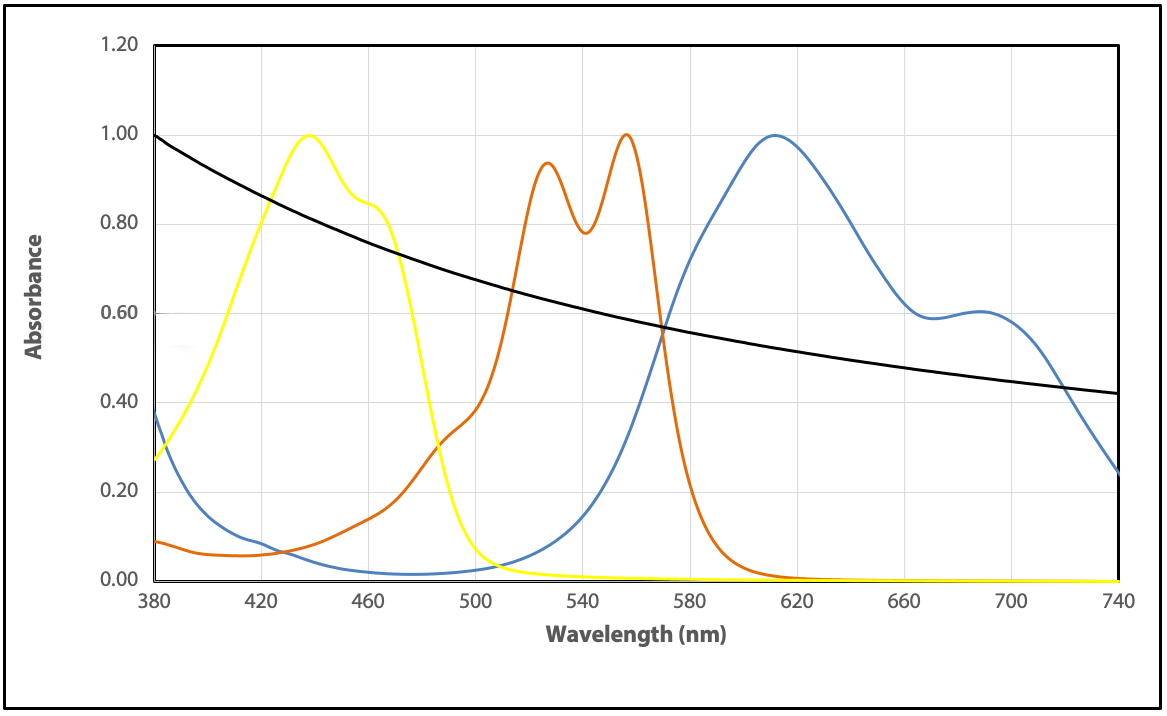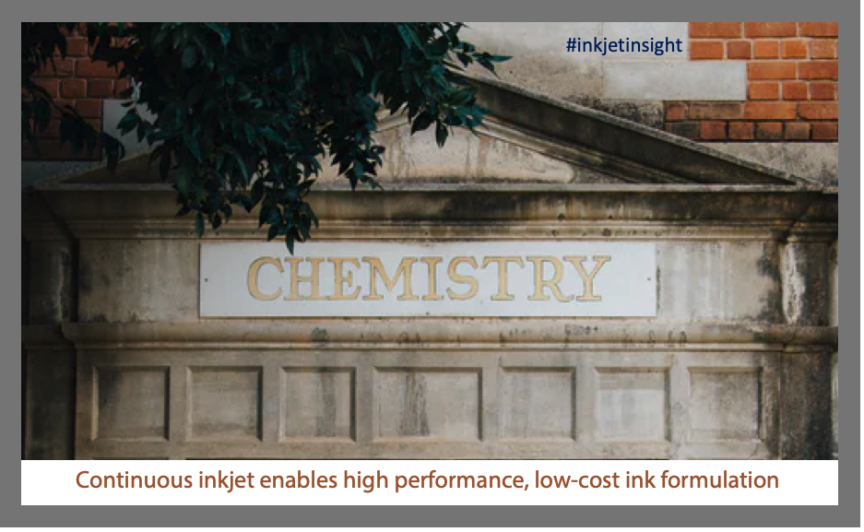Sponsored by Kodak
The productivity and quality characteristics of Continuous Inkjet (CIJ) that have driven its long popularity in commercial environments were covered in a previous article “Continuous Inkjet Firmly Entrenched in Commercial Markets.” We continued the analysis of CIJ relative to Drop-On-Demand (DOD) technologies such as thermal and piezoelectric with a discussion of media compatibility, running costs and how all of these features work together to create new opportunities for commercial printers. These previous articles focused on CIJ head technology, drop formation and placement. This current installment focuses on what is actually placed on the substrate: the ink. Here we break down ways that the CIJ approach allows pigmented inks to be developed that are high quality, sustainable, food safe and cost efficient.
Performance Attributes of Inkjet Inks
Core components of ink chemistry that contribute to its performance include:
- Pigment choice
- Pigment particle size and concentration
- Humectant choice
- Humectant or co-solvent concentration
These factors, taken together, drive performance quality characteristics such as optical density, color gamut, gloss differential, metamerism, and print durability. They also impact food safety, sustainability and overall cost.
Humectant level and pigment particle size are related. Smaller pigment particle sizes are critical to color strength, surface finish and print durability. They also enable lower pigment concentrations, which in turn allow for lower levels of humectants.
Higher humectant levels are required for Drop-on-Demand (DOD) inks in order to keep the inks from drying and clogging the inkjet nozzles when they are not firing. The combination of lower pigment concentrations and continuous ink flow allow for much lower levels of humectants in CIJ inks, as much as 75% less compared to typical DOD inks.
Formulation of Inks
Creating pigmented inks requires a two-step process. The first step involves the milling of pigment with water and a dispersant. During the first part of the process, pigment aggregates are broken into primary particles and then stabilized with dispersant molecules so that they will not clump and settle. The second step involves dilution with water and humectants along with surfactants, binders and other ink additives. Pigmented inks created using conventional milling processes end up with larger particle sizes as compared to other processes such as micromedia milling. By contrast, the proprietary micromedia milling process invented by Kodak results in nanoparticle pigment dispersions.
According to Doug Bugner, Director of Materials Development R&D for Eastman Kodak, the pigments in Kodak’s CIJ inks are very small with narrow particle size distributions, with median particle sizes ranging from 10 – 50 nanometers. This is dramatically smaller than piezoelectric DOD competitors with median pigment particle sizes typically ranging from 70 – 150 nanometers.
The concentration of a component in an ink is denoted by its weight percentage (wt%). As noted above, lower levels of humectants are needed with nanoparticle pigment distributions. “Humectant levels vary across inkjet systems with thermal DOD inks typically ranging between 10 – 25 wt%, piezoelectric inks typically ranging between 20 – 50 wt% while Kodak CIJ inks range from 4 – 8 wt%,” according to Bugner. Higher humectant levels, which keep inks from drying in and around the nozzles, also make it more difficult for inks to dry once they reach the substrate, leading to a higher risk of print defects and making it challenging to print at high speed on non-absorbing substrates, such as flexible packaging films.
Small but Mighty
Research has shown that inks with nanoparticle pigments with narrow distributions can achieve higher color density and wider color gamut than those with larger particles or broader distributions. Bugner explains, “This is because nanoparticle pigment distributions are much smaller than the wavelengths of visible light which results in very little light scattering as the light passes through the pigment ink, reflects off the substrate, and then passes back through the pigment layer to the eye of the observer. Less light scattering results in cleaner colors with higher chroma.”
For the same reason, this also results in excellent gloss properties. High gloss differential means that printed areas with different amounts of ink have a visible difference in the “shininess” of the surface. Printed pieces with high differential gloss can be seen as an inferior, especially in higher end commercial applications. Since most DOD inks have larger particle sizes, broader distributions, and higher concentrations of pigment, they scatter more light resulting in a narrower color gamut and higher levels of differential gloss as compared to CIJ inks.
According to Bugner, the metamerism of Kodak’s CIJ pigment inks, “is minimized by virtue of the very low light scattering as well as the high chroma of the pigments used.” Metamerism is a phenomenon that occurs when the perception of colors changes under different lighting conditions, affecting color accuracy and consistency in print production. The same low light scattering characteristics that improve differential gloss also reduce the differences in spectral reflectivity of colors under different light sources. Bugner adds, “We have specifically chosen pigments which have clean reflection spectra, meaning they have very little unwanted light absorption outside of their primary absorption bands. For example, our yellow pigment ink has a very clean absorption curve in the blue region, and very little absorption in the green and red regions. Likewise, the magenta ink absorbs strongly in the green, with very little blue or red absorption, and cyan absorbs strongly in the red, with very little blue or green absorptivity. Lastly, our pigment black ink has a smooth profile across the entire visible spectrum.”

“Less” Costs Less
Since humectants and pigments are two of the main contributors to cost from a raw materials perspective, lower levels of both bring cost savings. Kodak CIJ inks have lower concentrations of these materials compared to DOD aqueous inks. Kodak reduces costs even further by manufacturing their own pigment dispersions and inks, in contrast to many of their competitors who source their pigment dispersions and/or inks from other manufacturers. As noted above, the low humectants in Kodak’s proprietary CIJ inks also enhance drying, offering better compatibility on inkjet-challenging substrates such as coated and uncoated papers and flexible packaging materials.
Sustainability and Safe Use
The concentration of Volatile Organic Compounds (VOCs) and the level to which ink can be removed from printed pages for recycling are two aspects of ink formulation that are important for considering the future of clean inkjet printing. VOCs can also affect the safe use of an ink in food and personal care applications.
VOCs are organic chemical compounds that can evaporate quickly from inks due to their low boiling point and high vapor pressure. They are considered pollutants and are starting to become highly regulated due to concerns about their safety. Some humectants are considered VOCs, and Kodak inks use a small fraction of the humectant volume found in DOD inks. “Overall, Kodak CIJ inks have VOC ranges from 0.8-1.6 wt%,” according to Bugner, “making them much more sustainable and safer compared to DOD inks with higher levels of VOC additives.” When used as intended, Kodak’s CIJ inks are fully compliant with the latest directives for compostability as well as indirect food contact compliance including the:
- US Federal Food, Drug, and Cosmetic Act and applicable food additive regulations (21 C.F.R. Parts 170 et. seq.)
- Canadian Food and Drug Act and the Canadian Food and Drug Regulations (C.R.C., c. 870 Part B, Division 23)
- Good Manufacturing Practices (GMP) of the European Union, EU Regulation No. 2023/2006
- Annex VI of the Swiss Ordinance on Materials and Articles in Contact with Food (SR 817.023.21)
It is also notable that Kodak inks and fluids for food packaging do not contain any of the substances listed on the “Candidate List of Substances of Very High Concern (SVHC) for inclusion in Annex XIV of the EUs Regulation (EC) 1907/2006 on the Registration, Evaluation, Authorization and Restriction of Chemicals (REACH).
Recently, Kodak has also launched a set of Personal Care pigmented inkjet inks suitable for printing on products intended for direct skin contact, such as diapers and napkins. Careful selection and screening of ink components have allowed these inks to be receive industry recognized ISEGA certification for safe use in contact with human skin, mucous membranes and foodstuffs for a short period of time.
In order for a printed material to be reused, the printed image must be removed so the recovered substrate can be recycled. This is known as “deinking” as part of the paper recycling process. In general, pigment inks perform better than dye inks relative to deinking. Kodak’s CIJ pigment inks are considered to be “Good Deinkable” according to the INGEDE Method 11 protocols when used in combination with inkjet-optimized papers.
Summary
Nanoparticle pigments and continuous ink flow makes CIJ presses less prone to nozzle clogging, enabling very low humectant concentrations in the inks. These characteristics also drive performance in multiple areas that are critical to commercial print quality: optical density, color gamut, gloss differential, metamerism, and print durability.
At the same time, the chemical composition of these inks – particularly reduced concentration of pigment and humectants – leads to lower ink costs as well as delivering reliable performance in 24/7 production environments. Those are just a few of the things that are special about Kodak’s CIJ inks.
1 Alexandra D. Bermel and D. E. Bugner, “Particle Size Effects in Pigmented Ink Jet Inks” Journal of Imaging Science and Technology 43: 320–324 (1999).
2 Lokendra Pal and Dr. Paul Fleming, “The Study of Ink Pigment Dispersion Parameters” The Hilltop Review Volume 2 (2006).
3 KODAK ULTRASTREAM FOURTH-GENERATION CONTINUOUS INKJET TECHNOLOGY
4 What are volatile organic compounds (VOCs)? https://www.epa.gov/indoor-air-quality-iaq/what-are-volatile-organic-compounds-vocs

